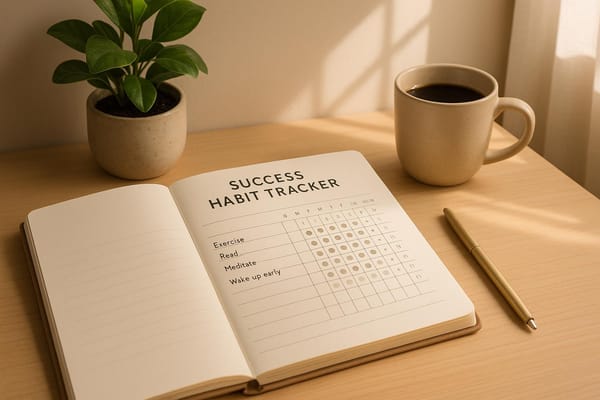Building Confidence: 5 Steps for Beginners
Learn practical steps to build confidence, from overcoming self-doubt to celebrating small achievements, and transform your self-perception.

Confidence is a skill you can develop over time. It helps you make decisions, communicate better, and handle challenges effectively. This guide outlines five practical steps to help beginners build confidence:
- Spot and challenge self-doubt: Identify negative self-talk, such as catastrophizing or labeling, and replace it with constructive thoughts.
- Set small, reachable goals: Break big goals into smaller tasks to create a cycle of progress and motivation.
- Practice self-affirmations: Use realistic, positive statements to reframe your mindset and build self-belief.
- Build new skills: Learn something new to boost your competence and confidence.
- Celebrate progress: Track achievements and reflect on your growth to reinforce positive habits.
Confidence grows with consistent effort. Start today by challenging one negative thought or setting a small goal. Over time, these steps can help you trust yourself, seize opportunities, and face challenges with assurance.
8. 5 Simple Steps to Build Confidence in less than 10 minutes
Step 1: Spot and Challenge Self-Doubt
Self-doubt is like an internal critic that chips away at your confidence, making you second-guess your worth and abilities. It can quietly linger in the background, influencing your decisions and outlook. The first step to overcoming it is recognizing that voice and learning to take control.
When left unchecked, negative self-talk can lead to anxiety, depression, and even poor decision-making. It wears down your self-esteem, making everyday tasks feel harder than they need to be. But here’s the good news: awareness is a powerful tool. By spotting these unhelpful thoughts, you can start replacing them with healthier, more constructive ones.
Recognizing Negative Self-Talk
Negative self-talk can sneak into your thoughts in different ways. Identifying these patterns is key to breaking free:
- Catastrophizing: Jumping to worst-case scenarios, like thinking a small mistake at work means disaster.
- Filtering: Only paying attention to criticism while ignoring praise.
- "Should" Statements: Setting rigid rules for yourself, like "I should have figured this out by now."
- Labeling: Defining yourself by a single misstep, such as thinking, "I’m so stupid."
- Personalizing: Assuming external events - like a friend’s short reply - are somehow your fault.
These patterns are worth pausing to reflect on. A thought journal can be a helpful tool for tracking and identifying recurring negative self-talk. Sharing your reflections with someone you trust can also offer perspective, helping you see these thoughts as opinions rather than facts.
Challenging Limiting Beliefs
Once you’ve identified negative self-talk, the next step is to challenge it. Limiting beliefs - those negative assumptions about yourself - often stem from past experiences and can hold you back.
Use the 3 C’s of Cognitive Behavioral Therapy (CBT): Catch the negative thought, Check its accuracy, and Change it into a more balanced idea. Start by writing down your limiting beliefs to separate them from reality. Then, look for evidence that supports or contradicts these beliefs. Ask yourself questions like: Is this thought based on facts? Have I always felt this way? Is there evidence that proves otherwise?.
Positive affirmations can help reframe your mindset. For instance, instead of saying, "I’m not good enough", try, "I’m learning and improving every day." Over time, this practice can help you embrace more empowering beliefs.
"The only fate governing your life is the fate determined by your own concepts, your own beliefs; for a belief, though false, if persisted in will harden into fact." - Neville Goddard
Keep an eye on your self-talk throughout the day, and challenge any limiting beliefs as soon as they pop up. With enough practice, replacing negative thoughts can become second nature.
Building a Reflection Practice
Daily reflection is a great way to keep self-doubt in check. It allows you to examine your thoughts, feelings, and actions, fostering self-awareness and personal growth. Regular reflection can also help you feel more in control and mindful.
Journaling is a simple yet effective way to gain perspective and challenge limiting beliefs. One helpful method is the "5 R’s" reflection exercise:
- Revel: Celebrate something positive from your day.
- Request: Identify something you need.
- Review: Look back on the day’s events.
- Reflect: Consider what you’ve learned.
- Resolve: Decide what you’ll do differently tomorrow.
Gratitude journaling - writing down things you’re proud of - can also shift your focus from what’s lacking to what’s going well. Pair this with mindfulness practices, like a few minutes of meditation, to observe your thoughts without judgment.
"Looking inward may activate your inner critic, but true self-reflection comes from a place of neutrality and non-judgment." - Kristin Wilson, LPC, CCTP
Set aside a specific time each day for reflection, ideally in a quiet, distraction-free space. Ask yourself open-ended questions like, "Am I spending my time on things that truly matter to me?" This practice will help you gain clarity and insight. Once you’ve tackled self-doubt, you’ll be ready to move on to setting achievable goals in Step 2.
Step 2: Set Small, Reachable Goals
After challenging your self-doubt in Step 1, it’s time to build momentum. The best way to do this? Set small, reachable goals. Big, lofty goals can feel overwhelming, but breaking them into bite-sized steps makes them much easier to tackle.
When you set smaller goals, you create a cycle of confidence-building. Each small win reinforces your belief in your abilities and gives you the motivation to keep going. What once seemed daunting becomes a series of manageable tasks you can check off one by one.
"Breaking down your goals clarifies the steps you need to take, which means you're much more likely to start moving forward. Also, the excitement of a goal wears off as you start moving forward and encountering challenges and setbacks. Having it broken down into smaller steps allows you to celebrate small wins and maintain motivation."
- anamcrae.ca
Breaking Down Big Goals
The trick to making big goals feel doable is to break them into smaller, actionable pieces. Start with the big picture and work backward. Keep breaking things down until you’ve got tasks you can complete in just a couple of hours.
Here’s a simple process to follow:
- Begin with your main goal and make sure it aligns with what truly matters to you.
- Outline the steps needed to achieve that goal, creating a 3–5 step framework.
- For each step, identify key projects or milestones. If a project feels too large, break it down further.
- Finally, create specific action steps - tasks you can schedule and complete in one focused work session.
For instance, let’s say your goal is to start a side business:
- Step 1: Research your market and validate your idea.
- Step 2: Create your product or service offering.
- Step 3: Build your online presence.
- Step 4: Launch and get your first customers.
- Step 5: Scale and grow your business.
Under "Build your online presence", you might have projects like creating a website, setting up social media accounts, and developing content. The website project could break down further into milestones such as choosing a domain name, designing the layout, writing the copy, and launching the site. Then, each milestone can be turned into small, actionable tasks like "research domain names for 1 hour" or "write homepage copy for 2 hours."
"This is the power of clarity: it creates confidence, and from there, consistent action becomes inevitable."
- anamcrae.ca
When you break things down like this, you gain clarity and focus. Instead of staring at a vague goal like "start a business" and feeling stuck, you'll see something specific like "research domain names" and think, "I can definitely handle that today."
Tracking and Celebrating Progress
Tracking your progress is a great way to stay motivated and remind yourself of how far you’ve come. It’s also an excellent way to build evidence of your capability.
Try keeping a progress journal where you jot down one small win each day. This could be as simple as:
- 12/15/2024: Spent 2 hours on market research and identified 3 competitors.
- 12/16/2024: Finished writing homepage copy and got positive feedback.
You can also use daily and weekly tracking systems. For daily tracking, a simple checklist or bullet journal works well - mark off completed tasks and schedule new ones into your calendar. For weekly reviews, take a moment to reflect on what went well, what didn’t, and how you can adjust your plans for the week ahead.
Small wins deserve to be celebrated. Whether it’s treating yourself to your favorite coffee, taking a relaxing walk, or spending time with a friend, these little rewards can reinforce your progress. Consider keeping a "done list" alongside your to-do list. Seeing all the tasks you’ve completed can be incredibly motivating.
"A small step is a win because it creates momentum that will propel you toward your bigger goals."
- Melissa Russell, Award-winning Journalist and Editor
When doubt creeps in, look back at your progress. It’s a powerful reminder of all the times you’ve succeeded.
Remember, it’s about progress, not perfection. Some days you’ll check off every task on your list, and other days you might only complete one. Both are steps forward. The key is to stay consistent over time, even if every day doesn’t go exactly as planned.
"Failure is success in progress."
- Albert Einstein
Step 3: Practice Self-Affirmations
Now that you've made some progress, it's time to focus on the way you talk to yourself. Self-affirmations are positive, intentional statements that challenge negative thoughts and help nurture a more confident mindset. Think of them as tools to reshape the way your brain works.
Research shows that self-affirmations activate brain areas tied to self-worth, motivation, and stress management, making them a powerful tool for personal growth.
"Every thought you think and every word you speak is an affirmation...You're affirming and creating your life experiences with every word and thought." - Louise Hay
But affirmations aren't just fluffy feel-good phrases. They have a practical impact, helping to rewire your brain so that positive and confident thoughts become second nature over time.
Creating Affirmations That Work
To make affirmations effective, they need to build on your small wins and align with your current mindset. One common pitfall is creating affirmations that feel too far-fetched. For instance, if you're struggling with confidence, saying "I'm the most successful person in the world" might feel insincere and backfire. Instead, aim for statements that stretch you but still feel believable.
For example:
- Instead of "I'm incredibly confident in every situation", try "I'm learning to trust myself more each day."
- Instead of "I'm amazing at public speaking", consider "I'm becoming more comfortable sharing my ideas in meetings."
Your affirmations should be specific, personal, and meaningful. Generic phrases like "I am amazing" lack the depth to make an impact. Focus on areas where you want to grow. For instance, if you're working on public speaking, affirmations like "I express my ideas clearly and calmly" or "My voice matters, and people value my perspective" are more effective.
Always use present-tense "I am" statements to ground your affirmations in the present moment.
"What you say to yourself matters because it is the basis of your actions, and your actions create your life experiences." - Dr. Jennice Vilhauer
If jumping straight into positive affirmations feels too overwhelming, start with neutral affirmations to bridge the gap. Instead of going from "I'm bad at this" to "I'm amazing at this", try statements like "I'm learning and improving" or "I'm capable of growth." These neutral phrases can help ease your mind into a more positive state.
You can also tie your affirmations to your core values. When affirmations are rooted in what truly matters to you, they become more effective at reducing stress and building confidence.
Making Affirmations Part of Your Day
Once you've created affirmations that resonate with you, the next step is to weave them into your daily life. You don't need a lot of time - just a few minutes each day can make a difference. The key is to make affirmations a natural part of your routine.
Morning practice works well for many people. You can repeat affirmations as you get ready for the day or while enjoying your morning coffee. If saying them out loud feels awkward, writing them down is just as effective.
To stay consistent, set a reminder on your phone or calendar. Aim to repeat your affirmations three to five times daily. You can also use visual cues like sticky notes placed on your bathroom mirror, computer screen, or car dashboard. These small reminders help reinforce positive thoughts throughout the day.
For a deeper practice, consider combining affirmations with meditation or quiet reflection. The goal is to make affirmations feel like a seamless part of your life, not just another chore.
"It's the repetition of affirmations that leads to belief. And once that belief becomes a deep conviction, things begin to happen." - Muhammad Ali
After about a month of practicing affirmations consistently, take a moment to reflect. Notice which statements resonate most with you and adjust them as needed. As your confidence grows, your affirmations should evolve to match your progress.
Step 4: Build New Skills
Once you've laid the groundwork with self-affirmations, the next step is to expand your abilities. Learning new skills not only helps you grow but also reinforces your belief in yourself. It’s a natural continuation of your progress, equipping you with tools to maintain and strengthen your confidence.
What makes skill-building so powerful is that it offers a double advantage. You gain practical abilities while also developing the mental toughness that comes with tackling challenges. Every time you master something new, you're sending a clear message to yourself: I can handle this. Tennis legend Arthur Ashe summed it up perfectly:
"One important key to success is self-confidence. A key to self-confidence is preparation".
Preparation through learning directly feeds into self-confidence. As Adam Lyons puts it:
"Confidence is competence".
The more skilled you become, the more assured you'll feel in your abilities.
Choosing the Right Activities
The first step in skill-building is to pick activities that align with your goals and interests. Start by identifying areas where you feel less confident and set clear improvement targets. For example, if speaking up in meetings makes you anxious, you might join a local Toastmasters club. If you're unsure of your physical abilities, try taking up hiking or learning a new sport.
It’s also helpful to choose activities that genuinely excite you. When you're passionate about what you're learning, you're more likely to stay committed, even when it gets tough. For instance, a graphic designer might build confidence by diving into photography, while someone in finance could explore creative writing or public speaking.
Focus on activities that push your boundaries - whether it’s communication, physical pursuits, creative hobbies, or technical skills. And remember, it’s better to dedicate consistent effort to one or two areas rather than spreading yourself too thin. Real progress in a focused area is key to building lasting confidence.
Once you've chosen your challenges, it’s time to embrace mistakes as part of the journey.
Using Mistakes as Growth
One of the biggest barriers to learning is the fear of making mistakes. But here’s the truth: mistakes aren’t just unavoidable - they’re essential. They’re how we learn and grow. Dr. Jacob Towery, an Adjunct Clinical Instructor at Stanford University, explains:
"The exciting news about mindsets is that they are absolutely changeable. The entire field of cognitive therapy is based on the idea that thoughts determine feelings and that you can learn powerful techniques to modify distorted thoughts and self-defeating beliefs".
In other words, the way you think about mistakes can completely transform your experience. Instead of fearing failure, view every error as a stepping stone toward improvement. Basketball legend Michael Jordan understood this well:
"I've missed more than 9,000 shots in my career. I've lost almost 300 games. I've failed over and over and over again in my life. And that is why I succeed".
When you stumble while learning a new skill, take a moment to analyze what went wrong and figure out how to improve. This approach turns setbacks into valuable learning experiences rather than sources of frustration.
Shifting your mindset from “failing” to “learning” can make a world of difference. For instance, if a presentation doesn’t go as planned, treat it as an opportunity to refine your communication skills rather than a reflection of your abilities. Research shows that adopting this growth mindset not only helps you learn from mistakes but also promotes brain development. By rewarding effort and persistence instead of focusing on innate talent, you create a path of continuous improvement.
John Maxwell put it best:
"A man must be big enough to admit his mistakes, smart enough to profit from them, and strong enough to correct them".
When you embrace mistakes as learning opportunities, they stop being confidence-breakers and start becoming confidence-builders. The goal isn’t to avoid errors - it’s to approach them with curiosity and a willingness to grow. By doing so, you lay the foundation for long-term confidence and unlock your full potential.
Step 5: Celebrate Progress and Review Achievements
Building confidence isn’t just about tackling challenges - it’s also about taking a moment to recognize how far you’ve come. Every time you develop new skills or overcome obstacles, acknowledging your progress reinforces your belief in your abilities. Celebrating these wins isn’t just a feel-good exercise; it’s a way to create a feedback loop that keeps you moving forward. Each small victory becomes proof that you’re capable of achieving more.
Science backs this up. Research shows that completing rewarding tasks triggers dopamine release, which fuels motivation and helps you stay on track. As Tony Robbins puts it:
"You can only build on success".
When you take time to celebrate your achievements - no matter how small - you’re laying the groundwork for future success. But if you don’t track these milestones, they can easily fade from memory, taking their confidence-boosting power with them.
Keeping an Achievement Log
One of the most effective ways to document your growth is by creating an achievement log. Think of it as your personal highlight reel - a dedicated space to record every win, breakthrough, and positive moment. The key is to be consistent and specific.
Start with a simple notebook, document, or app where you can jot down your accomplishments. Use clear dates in the American format, like July 10, 2025, to track your progress over time. Be as detailed as possible. For example, instead of writing “Did well in presentation,” note something like: “Presented quarterly report to 15 team members on July 10, 2025, and received positive feedback from my manager.”
Your log should include both major milestones and everyday successes. Here are some ideas to get started:
- Record measurable outcomes, like “Increased team efficiency by 20% after introducing a new workflow system in June 2025.”
- Note positive feedback from colleagues, clients, or managers - these external validations are powerful reminders of your abilities.
- Highlight moments of personal growth, such as building stronger relationships or streamlining a process that saves time for everyone.
Set aside time regularly - whether weekly or monthly - to update your log. Treat it like an important appointment. During these sessions, do what some experts call a “brain dump” of everything you’ve achieved recently. Keep the log open throughout the month so you can easily add new accomplishments as they happen.
Save tangible evidence of your wins too. Create a folder or portfolio where you can store certificates, positive emails, articles you’ve written, or photos from successful events. Having physical proof makes your achievements feel more real and gives you something to lean on when self-doubt creeps in.
Once your list is organized, print it out or keep it somewhere visible. This isn’t about boosting your ego - it’s about having hard evidence of your capabilities when your confidence wavers. It’s a tool to remind yourself of what you’ve already accomplished, so you can tackle future challenges with greater assurance.
Finding What Works
Tracking your wins is just the beginning. The real value comes from analyzing your success patterns to figure out which strategies work best for you. Not every confidence-building technique will be equally effective, and that’s okay. The goal is to identify the tools that give you the biggest boost so you can use them intentionally.
Review your achievement log regularly and look for trends. Ask yourself: What techniques were you using during your most successful moments? Did breaking a big project into smaller tasks help you stay focused? Did practicing affirmations make you feel more prepared for a challenging conversation? Did learning a new skill give you the confidence to take on a leadership role?
Here’s an example of how you might track and analyze your confidence-building strategies:
| Confidence Technique | Specific Example | Impact Level | Notes |
|---|---|---|---|
| Small Goal Setting | Breaking presentation into 5-minute daily prep sessions | High | Reduced anxiety, felt more prepared |
| Daily Affirmations | "I communicate clearly and confidently" for 2 weeks | Medium | Helped before meetings, less effective for technical tasks |
| Skill Building | Completed online public speaking course | High | Directly improved performance, boosted overall confidence |
| Achievement Review | Weekly log review every Friday | High | Consistent mood boost, better perspective on progress |
You might notice that affirmations work wonders in social situations but don’t help much with technical challenges. Or you might find that celebrating small wins daily keeps you motivated more effectively than waiting for big milestones.
Timing matters too. Some people find that reviewing their achievements first thing in the morning sets a positive tone for the day, while others prefer doing it at night to end on a high note. Pay attention to when you feel most confident and what you were doing in the days or weeks leading up to those moments.
The science supports this approach. Studies show that reflecting on your performance in an abstract way makes you more optimistic about future challenges and boosts your expectations for success. By regularly reviewing what’s working, you’re not just building confidence - you’re creating a personalized system to maintain it.
As legendary NFL coach Bill Parcells once said:
"Confidence comes from demonstrated skill".
Your achievement log becomes a living record of your demonstrated skills. The more evidence you collect, the more solid your confidence foundation becomes. And when you know which strategies work best for you, you’ll always have tools to rely on whenever you need a boost.
Conclusion: Building Confidence Step by Step
Building lasting confidence doesn’t happen overnight - it’s a process that requires consistent effort. By focusing on these five steps - challenging self-doubt, setting realistic goals, practicing affirmations, developing new skills, and celebrating progress - you can gradually reshape how you see yourself.
Studies suggest that confidence built steadily over time is more enduring than quick fixes, which can sometimes lead to overconfidence and setbacks. Taking the time to learn and grow creates a solid foundation, where even setbacks become opportunities to learn and improve.
Think of it like building physical strength. You wouldn’t expect to run a marathon after just a week of training, right? Confidence works the same way. Small, consistent wins along the way reinforce the belief that growth is possible and within reach.
At FromZeroToGrow, we encourage starting exactly where you are and progressing step by step. This practical, grounded approach ensures that each small victory builds on the last. As Norman Vincent Peale once said:
"Without a humble but reasonable confidence in your own powers you cannot be successful or happy".
Every journey is personal. For some, challenging negative self-talk might be the key. For others, celebrating small achievements could make all the difference. Applying these steps consistently allows you to create a confidence-building plan that works for you. It’s a method that FromZeroToGrow champions, helping you craft a path tailored to your unique needs.
Ultimately, confidence stems from trusting yourself - embracing your abilities, accepting who you are, and believing in your potential. This self-trust empowers you to take risks, seize opportunities, and build momentum for continued growth.
Start today. Challenge one negative thought, set a small goal, or take a moment to acknowledge a recent success. With steady practice, positive thinking, and a willingness to learn, your confidence will grow stronger over time - readying you for whatever lies ahead.
FAQs
How can I recognize and change negative self-talk to build confidence?
To notice negative self-talk, start by tuning in to your inner dialogue. Writing in a journal or simply reflecting on your thoughts can reveal patterns of negativity that might otherwise go unnoticed. Once you’ve spotted these patterns, ask yourself: Are these thoughts grounded in facts, or are they just assumptions? Then, challenge yourself to find a more balanced or optimistic way to interpret the situation.
Shifting negative self-talk involves reframing those thoughts into ones that are more constructive. For instance, instead of thinking, "I always mess up", try saying, "I’m learning and growing." Mindfulness techniques can also help you observe your thoughts without attaching judgment to them. Pair this with positive affirmations to strengthen your belief in yourself. Over time, these small adjustments can nurture a kinder, more encouraging inner voice.
What are some simple and achievable goals to help boost confidence?
Building confidence often begins with small, simple steps. For instance, you might commit to a 15-minute walk every day, jot down your thoughts in a journal for just 2 minutes when you're feeling overwhelmed, or spend 5 minutes each day practicing positive affirmations for a month. Another great way to boost your confidence is by tackling a small task, like organizing a messy desk or cleaning out a cluttered drawer. These achievable goals not only give you a sense of accomplishment but also help you build momentum, gradually reinforcing your confidence over time.
How can I start using self-affirmations daily without feeling uncomfortable or fake?
To make self-affirmations feel more authentic, start with straightforward and achievable statements that truly resonate with you. For example, try saying something like “I am learning and growing every day” or “I deserve kindness and respect.” The key is to pick affirmations that align with how you currently feel, so they come across as sincere rather than forced.
Find quiet moments in your daily routine to incorporate them - whether it’s while brushing your teeth, sipping your morning coffee, or winding down before bed. Speaking them out loud in front of a mirror can make them more impactful, but writing them down or repeating them silently works just as well. The secret lies in consistency. Over time, these affirmations can gently shift your self-perception, helping build confidence and a sense of self-worth.





